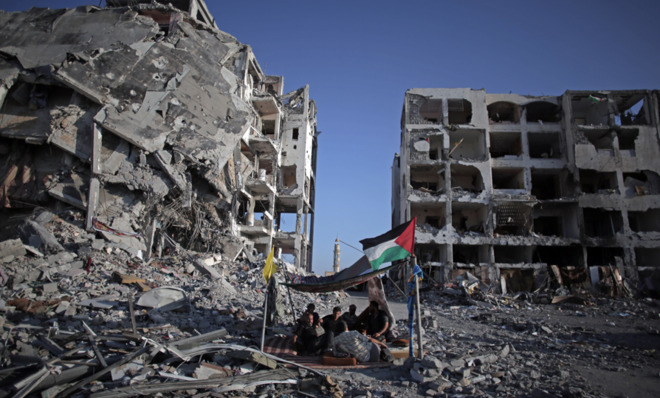Misery on the Gaza Strip
It's been called an "open-air prison" housing 1.8 million people. How did Gaza become such a humanitarian disaster?

How bad is the new damage?
It's catastrophic. In its military confrontation with Hamas, Israel destroyed more than 10,000 homes, leveling entire neighborhoods, and displaced nearly a quarter of Gaza's 1.8 million residents. Nearly 1,900 Palestinians were killed, including more than 400 children. Electricity is on only a few hours a day, hospitals are overloaded, and bodies are still believed to be buried under the debris created by Israeli missile attacks. And Gaza was already a humanitarian disaster zone before the bombs started falling. Almost half the population relied on the U.N. for food aid. About 80 percent of the population was living in poverty, and 40 percent was unemployed. "Before the conflict began, the people of Gaza were close to breaking point," said Saleh Saeed, head of the British charity the Disaster Emergency Committee. "Now we are seeing a humanitarian emergency affecting virtually every man, woman, and child.''
Why was the situation so dire?
The Week
Escape your echo chamber. Get the facts behind the news, plus analysis from multiple perspectives.

Sign up for The Week's Free Newsletters
From our morning news briefing to a weekly Good News Newsletter, get the best of The Week delivered directly to your inbox.
From our morning news briefing to a weekly Good News Newsletter, get the best of The Week delivered directly to your inbox.
In 2007, two years after Israel ended its decades-long occupation, the militant group Hamas seized control of the territory from its moderate rival Fatah, in a brief but bloody civil war. Hamas doesn't recognize Israel's right to exist and is pledged to its destruction. So when it took power, it intensified the rocket attacks on Israeli towns and cities, and the Jewish state responded by imposing a blockade to keep missiles and other weapons out of Hamas' hands. The blockade banned the importation of everything from building materials to computers to basic foodstuffs. It also barred most exports, prohibited Gazan fishermen from going more than a few miles out to sea, and made it nearly impossible for Gazans to leave the territory. British Prime Minister David Cameron has famously called the strip an "open-air prison."
Has the blockade worked?
If the goal was to keep arms out of Hamas' hands, no. The blockage did destroy Gaza's economy: Exports are now at less than 3 percent of what they were pre-blockade. But Hamas built a network of tunnels beneath the Egyptian border and smuggled in food, goods, building materials, and weapons. Egypt initially turned a blind eye to Hamas' activities, but when the pro-Hamas Muslim Brotherhood was ousted from power in Cairo last year, the new military regime destroyed the vast majority of tunnels into Egypt. This severed Gaza's lifeline to the outside world: Food and fuel prices soared, and a shortage of building materials stopped work on 19 of the territory's 20 construction projects. Hamas now insists that any long-term peace deal is contingent on Israel's lifting its blockade.
Is that likely to happen?
A free daily email with the biggest news stories of the day – and the best features from TheWeek.com
It would require a diplomatic breakthrough. Israel is very reluctant to lift the blockade because Hamas used vast amounts of concrete and cement — materials supposedly imported for the rebuilding of schools and homes — to create a sophisticated network of tunnels under the Israeli border. Unlike the smuggling tunnels leading to Egypt, these were built for the sole purpose of attacking or kidnapping Israelis; in 2006, Hamas used one to abduct a soldier, Gilad Shalit, who was eventually exchanged for 1,027 Palestinian prisoners. In recent weeks Israeli ground forces destroyed 32 "terror tunnels," but they admit that some may remain. "It's not a pleasant thought," said Eyal Brandeis, who lives a mile from where one of the tunnels was discovered, "that you sit one day on the patio drinking coffee and a bunch of terrorists will rise from the ground."
What would a peace deal require?
First of all, both sides have to be so sick of conflict and vengeance that they're willing to gamble on trusting each other. Israel will not negotiate directly with Hamas, so any peace deal must involve Palestinian Authority President Mahmoud Abbas. In April, Abbas announced a unity deal between his Fatah party, which dominates the ruling Palestinian Authority (PA) in the West Bank, and Hamas. At the time, this incensed Israeli Prime Minister Benjamin Netanyahu, since Hamas is openly devoted to Israel's annihilation, and led to the failure of U.S.-brokered peace talks. But now Netanyahu seems willing to deal with Abbas as a more responsible partner than Hamas. Israel's only alternative is endless war with Hamas and more bloody incursions.
Will Hamas really negotiate?
That remains to be seen, but it is clearly weakened: It lost hundreds of fighters, and its use of civilians as human shields has alienated much of the Arab world. Hamas' leaders have signaled willingness to allow the PA to manage Gaza's borders and oversee its reconstruction. Meanwhile, the high civilian death toll has put strong international pressure on Netanyahu to find a solution. Any long-term agreement would require major concessions on both sides. That's never happened in the past, and talks could easily break down. But the third Israeli-Hamas war in six years has created new desperation on both sides. "Sometimes out of blood, crisis, and catastrophe," said Fatah foreign policy adviser Husam Zomlot, "comes opportunity."
Israel's Iron Dome
It has been hailed as an "extraordinary homemade rocket swatter" — a "game changer" in the fight against Hamas. First deployed in 2011, Israel's Iron Dome anti-missile system is a set of nine missile batteries, positioned along the border, that blast incoming rockets out of the sky. Every time a rocket is fired from Gaza, the system tracks its trajectory and calculates where it is going to land; operators tend to launch one of the $95,000 interceptor missiles only if a built-up area is under threat. Israel claims the $1 billion program, which is largely funded by the U.S., is 90 percent effective. The 3,300 or so rockets that have been launched into Israeli airspace in the past few weeks have caused only three civilian deaths. Critics say the system removes the pressure on Israel's leaders to secure a peace settlement. But for Israelis, the Iron Dome has provided enormous relief. "I can't even explain with words how great it is," said Sivan Hadad from the city of Ashkelon. "Now I can go out. I still get scared, but not like before."
-
 Ashes to ashes, ducks to ducks: the end of Bazball?
Ashes to ashes, ducks to ducks: the end of Bazball?Talking Point Swashbuckling philosophy of England men’s cricket team ‘that once carried all along with it has become divisive and polarising’
-
 The strangely resilient phenomenon of stowaways on planes
The strangely resilient phenomenon of stowaways on planesIn The Spotlight Lapses in security are still allowing passengers to board flights without tickets or passports
-
 Four Seasons Seoul: a fascinating blend of old and new in South Korea
Four Seasons Seoul: a fascinating blend of old and new in South KoreaThe Week Recommends Located right in the heart of the action, this classy hotel is the perfect base to explore the capital